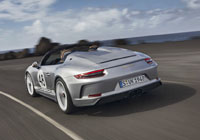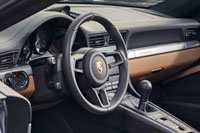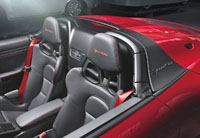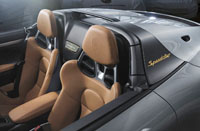
Last year, Porsche celebrated its 70th anniversary by producing the one-off 911 Speedster Concept, a beautiful modernization of its first-ever model, the 356 ‘No. 1’ Roadster from 1948. This sent the motoring press and many fans of the brand into an uproar about future production, resulting in the 2019 911 Speedster seen here.
The Speedster is now available to order from you local Porsche retailer for just $312,500, a mere $149,200 more than the 911 GT3 Coupe that it’s based on. And yes, that means the all-new Speedster rides on outgoing 991 hardware, not the upcoming 2020 911 (992) that’s been top of the news headlines lately.
We’re guessing the exclusive club of 1,948 buyers receiving their limited edition Speedsters toward the end of 2019 won’t care one whit about which chassis it rides on, chiefly because the Speedster is gorgeous and 991 underpinnings have been arguably Porsche’s best yet, at least when uprated to GT3 or GT2 guise.

Also notable, the renewed GT3 Coupe won’t arrive in 992 form for quite some time, and therefore the only way you’re going to get your hands on a 500-plus horsepower 4.0-litre flat-six crammed aft of the rear axle, capable of a screaming 9,000-rpm redline and generous 346 lb-ft of torque, is to opt for a current GT3 or choose the instantly collectable 911 Speedster, the newer model in fact good for a minor increase to 502 horsepower thanks to throttle bodies added from the GT3 R race car.
The results of all this go-fast tech is a 4.0-second run from zero to 100km/h, which is just 0.1 seconds off the GT3’s pace, while its terminal velocity is 310 km/h, a mere 10 km/h slower than the GT3, despite not having its massive rear wing.
What’s more, when you factor in that the Speedster only provides Porsche’s GT Sport six-speed manual transmission, which is also pulled from the GT3 and shaves four kilos from the seven-speed manual used for the regular 911, that standstill sprint to 100km/h score is even more amazing, because Porsche’s paddle shift-actuated dual-clutch PDK automated transmission is always quicker.

Together with the GT3 powertrain, which comes with dynamic engine mounts from the GT3 by the way, the Speedster utilizes the supercar-beating model’s uprated chassis that incorporates a uniquely calibrated rear axle steering system, although this is where similarities between the two Porsche models end, because body mods are so significant that it’s hard to tell whether the two cars have much of anything in common. These include lower cut front and side windows, twin “streamliners” shaped from carbon fibre on the rear deck, these completely consuming the rear seating area, carbon fibre composite front fenders and hood, front and rear fascias formed from polyurethane, plus a lightweight manual fabric top.
It was smart for Porsche to upgrade the roof for easier day-to-day usability, as the concept only featured a button-down tonneau cover that would’ve caused nothing but aggravation to its potential owners, while the automaker also deleted the “X” markings on the headlamp lenses that stylistically reminded history buffs about the tape once used to make sure broken glass didn’t end up on the racetrack to puncture tires; the removal of the 1950s-type aluminum fuel filler cap on the concept’s hood for fast refueling of the gas tank below; plus replacement of the Talbot mirror housings that were popular back when the 356 was around, to stock side mirrors.
Fans of that now highly collectible classic 356 will no doubt be happy that Porsche left the gold-coloured “Speedster” lettering on the thick B-pillars and rear engine cover unmolested, but this said you’ll need to add a special upgrade package (see below) to get them.

All the carbon fibre mentioned earlier should make it clear that Porsche wanted its Speedster to be as light as possible, with the premium brand even going so far as to delete the stereo and air conditioning in base trim (they’re optional), but with a focus on performance they added a standard set of beefed up, lighter weight carbon ceramic brakes, boasting bright yellow six-piston aluminum monobloc fixed calipers in the front and four-piston aluminium monobloc fixed calipers at back, these slicing a whopping 50 percent of weight from the regular 911’s cast iron rotors. Ringing those brakes are centre-lock Satin Black-painted 20-inch alloy wheels on Ultra High Performance (UHP) tires, aiding grip even further.
Looking inside, the Speedster includes lighter weight door panels with storage nets and door pulls, plus the standard black leather can be improved with red stitching on the instrument panel and headrests with embroidered “Speedster” lettering. The door pulls come in red with the upgrade, while Porsche adds a unique GT Sport steering wheel infused with a red centre marker at the 12 o’clock marker. The Speedster interior also features a beautiful carbon fibre shift knob, and carbon fibre doorsill kick plates with “Speedster” monikers.

Those attracted to the new 911 Speedster for its classic proportions and design can opt for a special Heritage Design Package that comes much closer to last year’s concept and ‘50s-era 356 Speedsters. The upgrade adds white front bumper and fender “arrows” on top of GT Silver Metallic paint, while this is how you get the aforementioned gold Speedster lettering too, plus classic Porsche crests. Also, the door-mounted racing-style number stickers can be removed if you don’t like them, but then again if you choose to keep them you can also include your own personal number. Lastly, the upgraded Heritage interior gets two-tone leather with classic Porsche crests sewn onto the headrests, plus body-colour trim gets added to the dash and seatbacks.
If the new 911 Speedster sounds like your kind of car, be sure to call your local Porsche dealer quickly, and while you’re waiting for delivery of this ultimate drop-top, enjoy a couple of videos below:
The new Porsche 911 Speedster: First Driving Footage (1:13):
The new Porsche 911 Speedster: Highlight Film (2:10):
Story credits: Trevor Hofmann
Photo credits: Porsche
